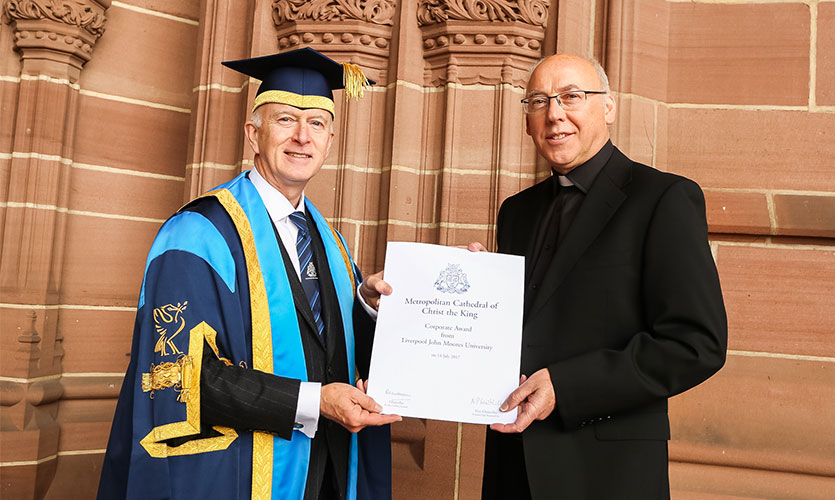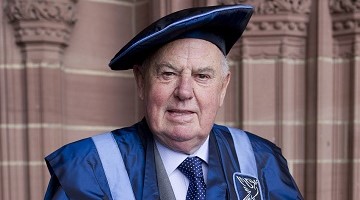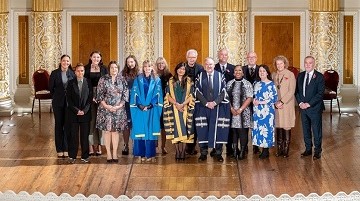Corporate Award Metropolitan Cathedral of Christ the King

Honorable Pro-Chancellor, it is with great pleasure that in this, their 50th anniversary year, I present the Liverpool Metropolitan Cathedral for a corporate award from the University.
It may seem strange to celebrate the award of one Cathedral in the other, but here in Liverpool, the relationship between the two great Cathedrals is one we all celebrate for the proximity in which they operate – bestriding the aptly named Hope Street – and for the truly authentic partnership they enjoy with the communities they both serve.
That the Met, as it is more commonly known is just 50 years old and yet has been part of the upper skyline of the city for so long, just serves to remind us of how familiar these great buildings have become in our daily lives.
The Metropolitan Cathedral of Christ the King is the seat of the Archbishop of Liverpool and the mother church of the Roman Catholic Archdiocese of Liverpool. The grade II listed building was completed and consecrated in 1967 after the architect Frederick Gibberd won a worldwide design competition. It is now the largest Catholic Cathedral in England.
At the time of building it was likened to something from the Apollo space station, locals nicknamed it the Mersey Funnel or the Wigwam.
And it is perhaps this colloquial, affectionate irreverence that makes the Met a public building like no other.
I would like to read a few comments from an essay written by one of our academics, Professor Joe Moran, who was invited to celebrate the anniversary in a piece for the Guardian a few weeks ago. Joe’s description perfectly sums up the very human appeal of the Cathedral:
“On the piazza that Gibberd built over the roof of Lutyens’s crypt, impromptu games of football break out. On the outdoor plinths, packed lunches are unfurled. On the 56 steps up to the entrance, the same man jogs eternally up and down, like Rocky Balboa on the steps of the Philadelphia Museum of Art.
Nowadays public places can feel almost too welcoming. The cathedral invites you in but without seeming needy like this. It never asks you to “get involved” or “have your say”. It does not offer free Wi-Fi. It has none of that jazz-hands jolliness where everyone is “excited” and “passionate” to be serving whatever it is they are serving you.
The cathedral is a place to go, in other words, when the rest of the world feels shouty and oversold. It asks nothing of you, other than that you match its quietness with your own. Since libraries became spaces for “social learning”, and the quiet zones on trains became just slightly less noisy zones, a cathedral is now almost the only public place where us deep introverts can inhale that scarce and precious drug, silence.
The final element of Gibberd’s plan, the ceremonial steps up to the main doors, was not completed until 2003. Like Rome’s Spanish Steps, these steps draw the eye but also lead your gaze up and beyond them. You can best feel their effect by walking along Hope Street in the late afternoon of a December Sunday. It’s dark and cold and you have that stomach-tightening, fag-end-of-the-weekend, work-in-the-morning feeling. But the tower is brightly lit from the inside, the bells are calling people in for carols, and the steps motion you up to warmth, light and hope.”
In their Golden anniversary year, and in the presence of the Bishop, the Archbishop, and Cathedral representatives, it gives me great pleasure to invite the Dean, Father Tony O’Brien to accept our highest organisational honour for the Liverpool Metropolitan Cathedral for their outstanding contribution to faith and community in Liverpool.


